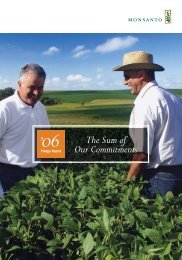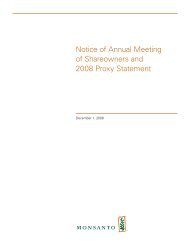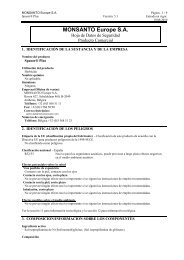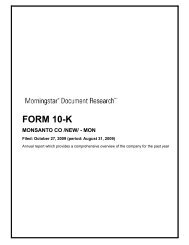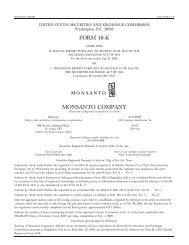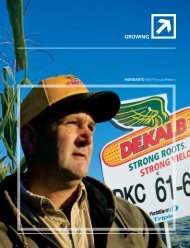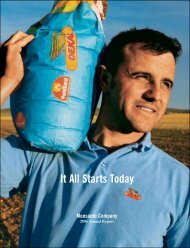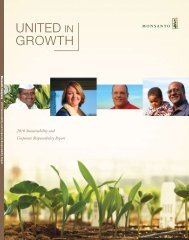You also want an ePaper? Increase the reach of your titles
YUMPU automatically turns print PDFs into web optimized ePapers that Google loves.
GLOBAL CHALLENGE #2: FOOD SECURITY<br />
THE ISSUE<br />
The United Nations Food and Agriculture Organization (FAO) defines food security as a<br />
“state of affairs where all people at all times have access to safe and nutritious food to maintain a healthy<br />
and active life.” Worldwide, the FAO estimates that “842 million people were undernourished in 1999-2001.<br />
This includes 10 million in the industrialized countries, 34 million in countries in transition, and 798 million<br />
in developing countries. At the regional level, the numbers of undernourished were reduced in Asia and the<br />
Pacific and in Latin America and the Caribbean. In contrast, the numbers continue to rise in sub-Saharan<br />
Africa and in the Near East and North Africa.” 2<br />
THE ROLE OF AGRICULTURE<br />
In addition to declining soil productivity and environmental damage, increasing competition<br />
for fresh water is a significant obstacle to achieving greater food security. The need for fresh water is rapidly<br />
increasing as population levels rise. The demand exceeds the availability in some parts of the world. Agriculture,<br />
by far the largest user of fresh water, competes with urban areas for limited supplies.<br />
“In much of the developing world, growing urban and industrial water demand will require<br />
transfers of water from agricultural uses, threatening food production and rural livelihoods.” According to the<br />
International Food Policy Institute (IFPRI) and the International Water Management Institute (IWMI), in 1995<br />
irrigation for agriculture used about 80 percent of available global fresh water and about 86 percent of the<br />
fresh water available in developing countries. 12<br />
Increasing large-scale agricultural efficiency and helping smaller producers succeed are<br />
the keys to ensuring greater food security around the world. Among the tools that can make a difference are<br />
modern technology and ag systems expertise. <strong>Monsanto</strong> is dedicated to contributing to both.<br />
Although the trends until now have not been positive, there is room for optimism. The tools<br />
to achieve food security exist, explains Jeffrey D. Sachs, a highly respected expert on poverty and food security.<br />
In a speech at the World Food Prize Symposium in Des Moines, Iowa in 2003, he said, “Despairing poverty<br />
is not an impossible challenge. It is an utterly solvable challenge, given the enormous talents and knowledge,<br />
the powerful technologies, and the proven track record that we have.” 13<br />
MONSANTO’S CONTRIBUTION<br />
Through higher-yielding seeds, traits that require less tillage and pesticides, and knowledge<br />
of integrated agricultural systems, <strong>Monsanto</strong> is in a position to help growers, both large and small, to increase<br />
food production and thereby improve food security. <strong>Monsanto</strong> works with large growers to help them maximize<br />
yields and protect the environment. It helps small farmers with products adapted to their needs — to help them<br />
become more productive. It works with governments and nongovernmental groups to give small growers access<br />
to the inputs they need and to commercial markets for their surplus. <strong>Monsanto</strong> also works with international<br />
research institutes to transfer technology where appropriate to fight pests and to address micronutrient issues<br />
such as vitamin A deficiency in diets.<br />
{ MONSANTO COMPANY 2004 PLEDGE REPORT: PAGES 8-9 }



